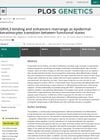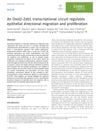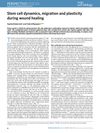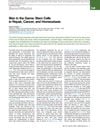Search
forLearn
4 / 4 resultslearn Osteopontin
signaling protein that, when suppressed, may grow hair by reducing inflammation and stem cell loss
learn Thymosin Beta 4
learn Low Level Laser Therapy
laser therapy for anti-inflammatory and likely insignificant hair regrowth effects
Research
5 / 1000+ results
research GRHL3 Binding and Enhancers Rearrange as Epidermal Keratinocytes Transition Between Functional States
GRHL3 is important for controlling gene activity in skin cells during different stages of their development.

research An Ovol2-Zeb1 Transcriptional Circuit Regulates Epithelial Directional Migration and Proliferation
The Ovol2-Zeb1 circuit is crucial for skin healing and hair growth by guiding cell movement and growth.

research Stem Cell Dynamics, Migration, and Plasticity During Wound Healing
Stem cells help heal skin wounds by moving and changing roles, working with other cells, and needing more research on their activation and behavior.
research Effect of Tribulus Terrestris Extract on Melanocyte-Stimulating Hormone Expression in Mouse Hair Follicles
Tribulus terrestris extract significantly increases MSH expression and melanin production in mouse hair follicles.

research Skin in the Game: Stem Cells in Repair, Cancer, and Homeostasis
Elaine Fuchs' research shows how skin stem cells maintain health, aid in healing, and are involved in cancer.
Community Join
5 / 82 resultscommunity Eirion Therapeutics Announces Potential Breakthrough Treatment for Hair Loss Based on First-in-Man Clinical Trial Results
ET-02, a new hair loss treatment, shows promising results with a 6-fold increase in hair count, potentially outperforming minoxidil by activating stem cells in hair follicles. Further trials are ongoing to confirm its efficacy and safety, with potential market release in the future.

community Compressed part of research of theory of androgenic/anabolitic balance. AGA h-responders analytic. Theory of physio-metabolitic method of anti AGA treatment
The treatment for androgenetic alopecia involves using finasteride and minoxidil with intense exercise and cold exposure to boost metabolism and reduce androgenic effects, potentially leading to hair regrowth. This approach may activate biological pathways for improved hair and overall health.
community Sup Chooms?! How y’all living?!
A 35-year-old shared their 5-month hair regrowth progress, using 0.5mg oral finasteride daily, topical minoxidil/finasteride once daily, derma stamping 1-3 times a week, washing hair daily or every other day with peppermint soap, and using eczema lotion for scalp health. Commenters congratulated the individual on the significant improvement in their hairline.
community Clearing the air on how non-surgical treatments really work
Treatments for hair loss, including finasteride, dutasteride, minoxidil, ketoconazole, microneedling, and low level laser light therapy, which aim to reduce DHT production, increase cell absorption and blood flow, and stimulate epidermal stem cells. It also stresses the importance of patience when using these treatments.
community Is tazarotene potentially better than tretinoin in combination with topical minoxidil?
Tazarotene may be more effective than tretinoin when combined with topical minoxidil for hair loss due to its selective binding to RAR-beta and gamma, though it can cause irritation. Tazarotene's potency can lead to indirect inflammatory reactions despite potentially causing less irritation than tretinoin.